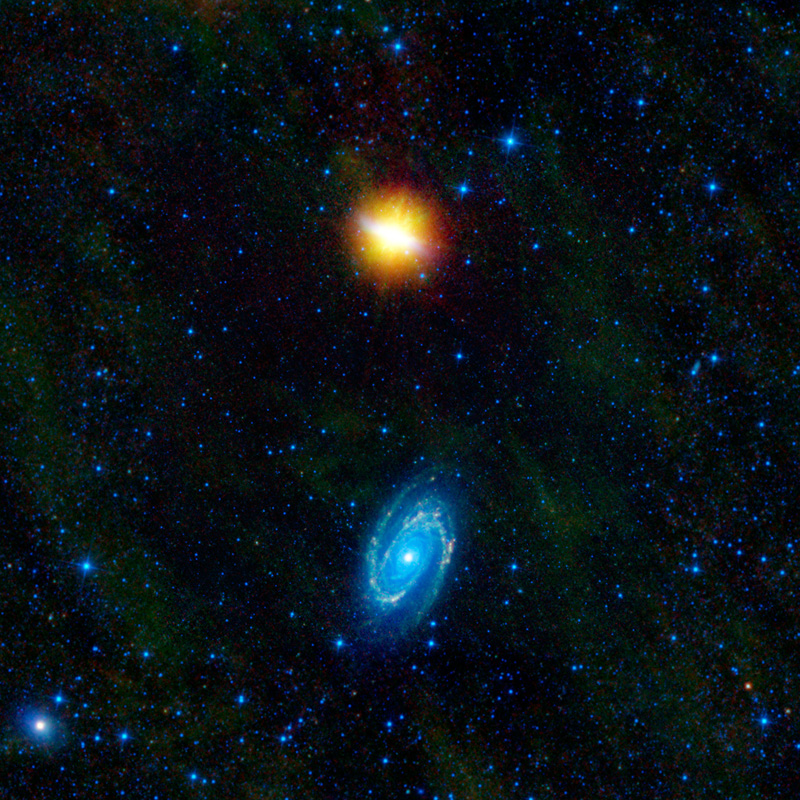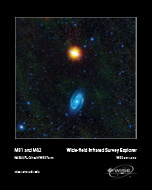|
 |


Jan 13, 2011 - WISE Beholds a Pair of Dancing Galaxies
This image from NASA’s Wide-Field Infrared Survey Explorer, or WISE, features two stunning galaxies engaged in an intergalactic dance. The galaxies, Messier 81 and Messier 82, swept by each other a few hundred million years ago, and will likely continue to twirl around each multiple times before eventually merging into a single galaxy. The relatively recent encounter triggered a spectacular burst of star formation visible in both galaxies.
Messier 81 (bottom of image) is a prototypical “grand design” spiral galaxy with its pronounced and well-defined arms spiraling into its core. At the wavelengths WISE sees, these beautiful arms show areas of compressed interstellar gas and dust, which go hand-in-hand with areas of increased star formation. The spiral density waves that create this compression and star formation have been enhanced by the close gravitational interaction with its partner galaxy, Messier 82, causing the arms to appear more prominent than in a similarly isolated spiral galaxy.
Messier 82 (top of image) is also a spiral galaxy, however it is seen edge-on from our point of view. It was originally classified as an irregular galaxy, until 2005, when astronomers were able to tease out spiral structure in near-infrared images (similar to wavelengths that WISE sees). Viewed in visible wavelengths, this galaxy appears to have a long thin bar shape, hence its common name the Cigar Galaxy.
Messier 82 is also a starburst galaxy, meaning it is currently undergoing a period of exceptionally high rates of star formation. This huge burst of activity was caused by its close encounter with Messier 81, whose gravitational influence caused gas near the center of Messier 82 to rapidly compress. This compression triggered an explosion of star formation concentrated near the core. The intense radiation from all of the newly formed massive stars creates a galactic “superwind” that is blowing massive amounts of gas and dust out perpendicular to the plane of the galaxy. This ejected material (seen as the orange/yellow areas extending up and down) is made mostly of polycyclic aromatic hydrocarbons, which are common products of combustion here on Earth. It can literally be thought of as the smoke from the cigar.
A third, smaller galaxy, NGC 3077, can be seen at lower left. This spiral galaxy belongs to the same group as Messier 81 and Messier 82 -- a group that includes at least a dozen gravitationally linked galaxies. NGC 3077 is also experiencing a burst of new star birth, likely triggered by its interaction with Messier 81.
Messier 81 and Messier 82 are both very bright galaxies and can be seen on a clear, dark night with binoculars in the northern constellation Ursa Major, which contains the Big Dipper. In visible light Messier 81 is one of the brightest galaxies that can be seen. Messier 82 is not as bright at visible wavelengths, but in infrared light it is by far the brightest galaxy in the entire night sky.
This image was made from observations by all four infrared detectors aboard WISE. Blue and cyan (blue-green) represent infrared light at wavelengths of 3.4 and 4.6 microns, which is primarily light from stars. Green and red represent light at 12 and 22 microns, which is primarily emission from warm dust.
Image Credit: NASA/JPL-Caltech/WISE Team
Click here to view JPL's press release.
|
|
| |
|
| -About the Object- |
| Names: Messier 81 (NGC 3031, Bode’s Galaxy); Messier 82 (NGC 3034, Cigar Galaxy); NGC 3077 |
| Type: Galaxy>Spiral; Galaxy>Spiral; Galaxy>Irregular |
Distance: 12 million light-years for M81 Group, about 150,000 light-years separating M81 & M82. |
| Size: 94,000 light-year (M81); 40,000 light-years (M82); 19,000 light-years (NGC 3077). |
| -About the Image- |
| Position of objects (J2000): RA 9h 55m 33s; Dec +69° 03’ 55” (M81) |
| Constellation: Ursa Major |
| Field of View: 1.5 x 1.5 degrees |
| Orientation: North is straight up |
| Color Mapping: Blue=3.4 microns; Cyan=4.6 microns; Green=12 microns; Red=22 microns |
|
|





